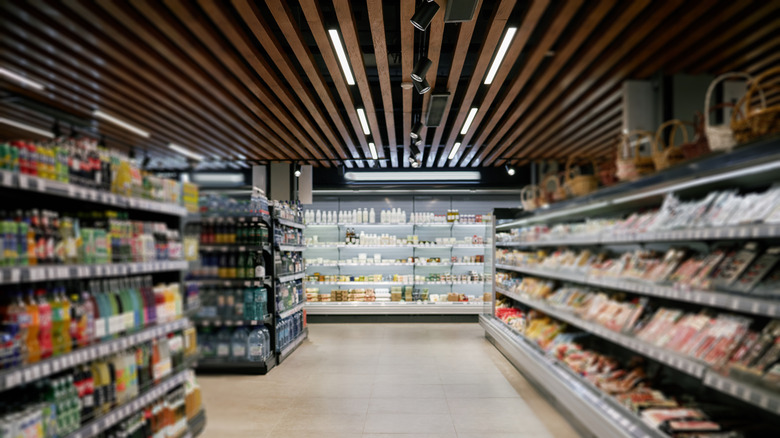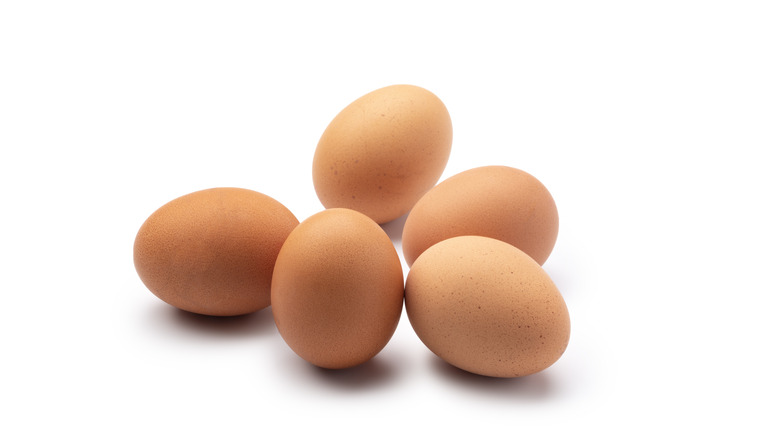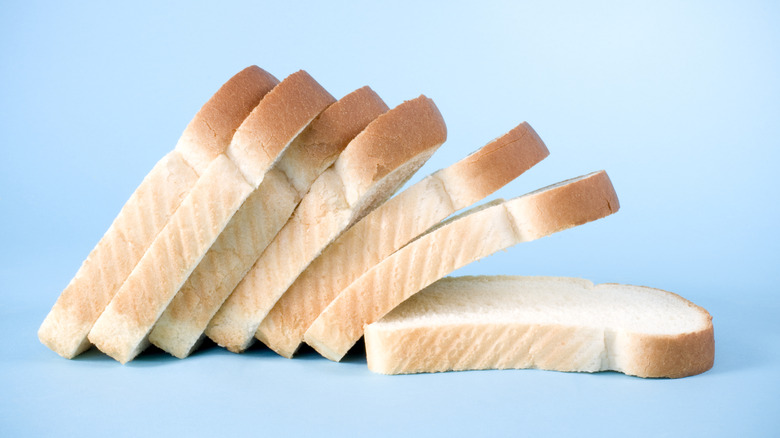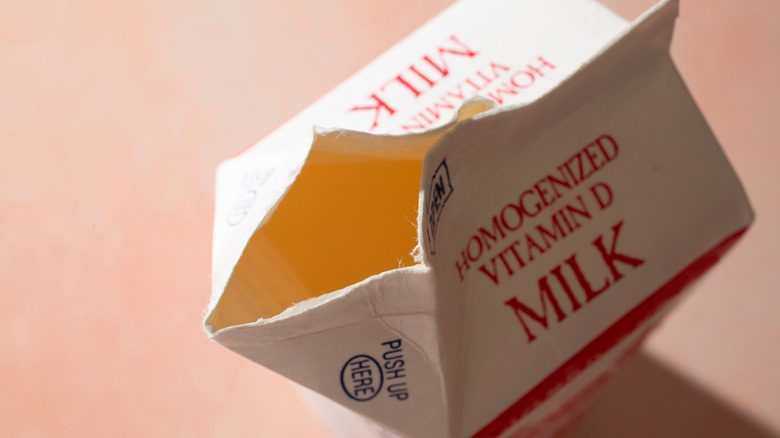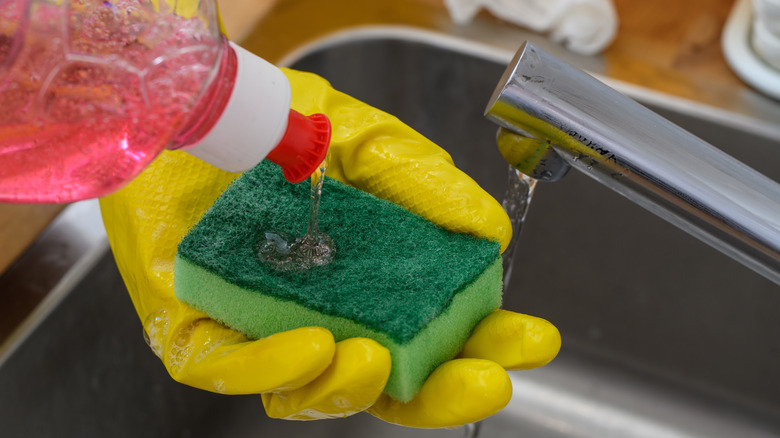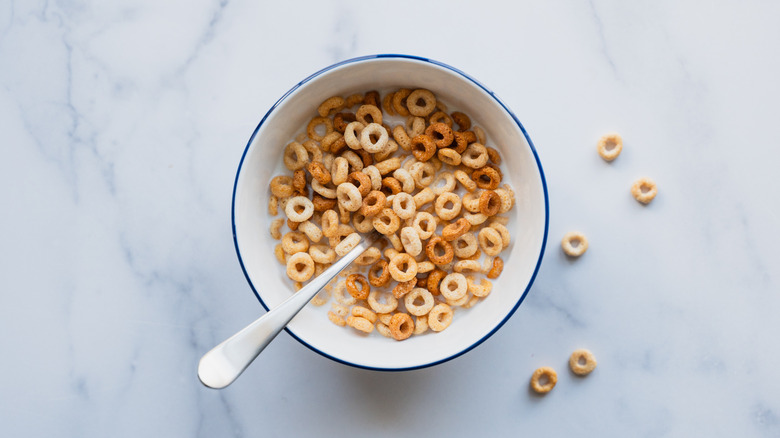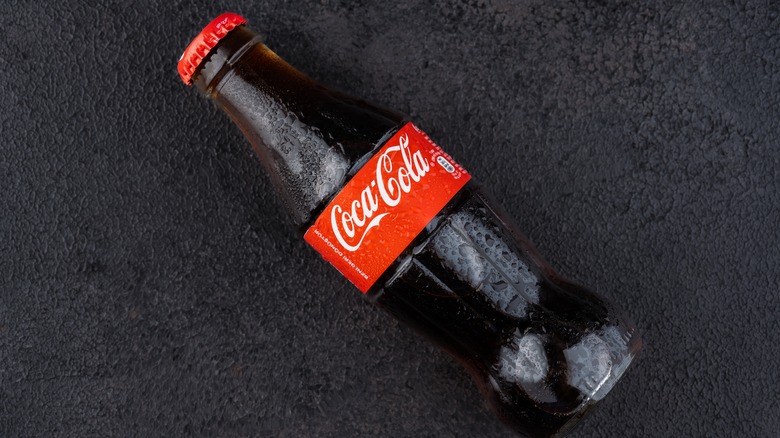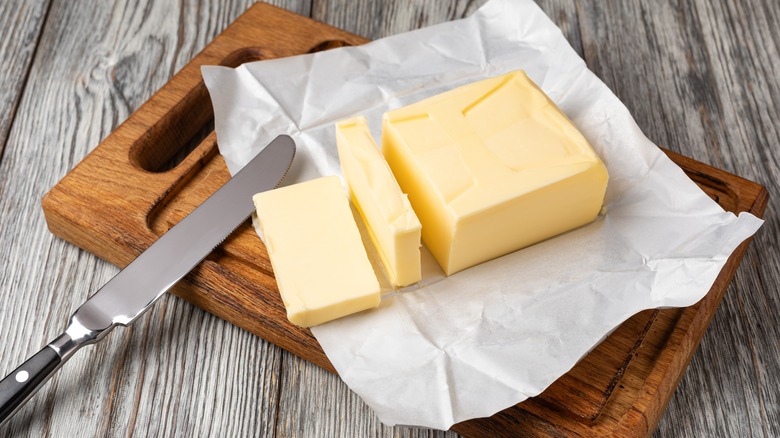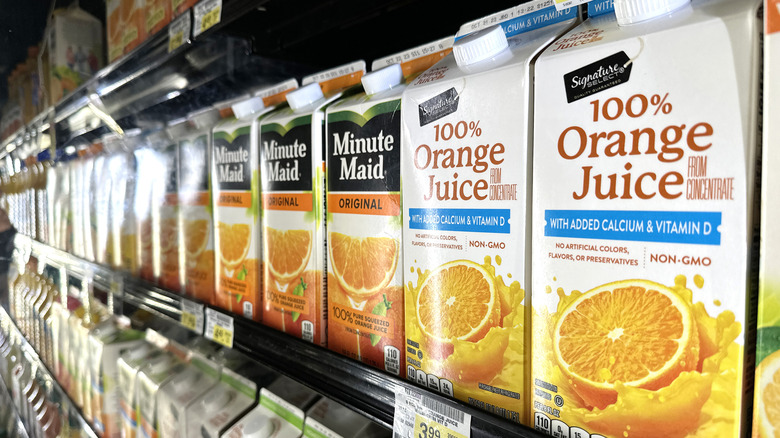1970s Groceries That Used To Cost Pennies
We may receive a commission on purchases made from links.
To say grocery shopping in the United States has gotten extremely expensive is an understatement. The U.S. Bureau of Labor Statistics estimates that Americans spend approximately $504 per month on groceries, which works out to $$6,053 per year. Whether through sensible budgeting or opting for dollar-store purchases, Americans are trying to save as much money as possible in 2025.
For some Americans, it's hard not to look at the ever-increasing prices of grocery items from dish detergent to a carton of eggs and remember a time when these items were extremely cheap. If you were a child or teen in the 1970s, you may remember your parents being stressed about spending more than $40 at the local grocery store. A dollar from that decade was worth several times what it is today. At a time before supermarkets and megastores like Walmart and Target were ubiquotous, one dollar could buy several items at once. Today, you're lucky to find an item for less than $1 at a dollar store. Here are some grocery items from the 1970s that, if you bought them then, would cost pennies compared to what they do now.
Eggs
According to Statista, the average American consumes about 273 eggs each year. Considering the current population total, that would put national egg consumption at around 95 billion per year. While egg purchases show no signs of slowing down overall, the rising cost may mean Americans aren't able to buy as many as they would prefer, or as often. This wasn't always the case.
If you went shopping for a dozen eggs in 1970, you could expect to pay $0.61. There was an inflation-driven price increase across the 1970s, brought on by a financial crisis that affected grocery prices, and eggs were no exception. A dozen eggs cost around $0.80 by the end of the decade. Meanwhile, as of January 2025, the average price of eggs in the U.S. is $4.95, meaning that we are paying several times more for a carton of eggs today than our parents and grandparents did during the '70s. It means that we had the chance to buy eggs today using 1970s prices, which would represent the ultimate opportunity to bulk buy for future baking projects.
The 1970s saw a rise in alternatives to eggs as concerns about cholesterol consumption grew. Shoppers of the time might have opted for Fleischman's Egg Beaters, an egg substitute released in 1972. Americans of the time might have been better prepared to embrace a full serving of cholesterol than pay $3.55 for a small carton of Egg Beaters.
Bread
As great as sliced bread is for sandwiches and toast, the price might make you cringe, especially if you were a '70s kid whose family previously paid pennies for it. In a Facebook discussion thread, the top post revealed that in 1970, a loaf of bread cost $0.25. As commenters reminisced about previous pricing, a commenter named Mike Bennett broke down how it was that Americans of the time could afford to pay so little for their groceries. Said Bennet, "In 1970, the average income of a census family was $9,600. By 1980, it had almost tripled to $26,700." Another commenter pointed out in response that $0.25 in 1970 become $1.94 in 2024, observing that the price of bread "has not only kept up with inflation, it has exceeded it."
Inflation did impact the price of bread significantly over the course of the 1970s, reportedly doubling to around $0.50 per loaf. Even then, loaves went for nearly half the price as the cheapest brand and off-brand options currently found on grocery store shelves.
Milk
Many Americans take for granted that milk has always been something readily available through the local supermarket or grocery store. But for previous generations, dairy products were typically brought to your doorstep by way of the milkman. But times changed, and by the 1970s as few as 7% of American households were still getting dairy items delivered to their home by milkmen. Instead, you were now able to buy cartons in person. In stores, you could pay around $1.75 for a gallon of milk. Today, that would be enough to get you a half-gallon of milk at Walmart. An entire gallon would cost around $2.50 instead. Meanwhile, children who purchased milk at school might have felt some stress after the price of their milk doubled in 1970, going from $0.04 to $0.08.
The concept of paying less than a dime for your child's milk would certainly be mind-blowing in 2025, at a time when school lunches have become increasingly unaffordable for many children across the country. As CBS News reports, school lunch prices average $2.95 per day in elementary schools and $3.20 in high schools. Though some might consider these prices reasonable, a family in the 1970s would strongly disagree.
Dish soap
If you were looking to get your dishes clean back in the 1970s, the preferred brands of the era were Joy, Dawn, Dove, and Lux. If it's 1972, and you need a one-quart bottle of Joy dishwashing liquid, it would have cost $0.75. Dawn dish detergent debuted in American stores a year later and was similarly priced for much of the decade, costing $1.19 by the 1980s.
While Joy is still around, it isn't nearly as popular as it once was. Meanwhile, Dawn remains among the best-reviewed dish soaps on the market. The good news is that you can still find bottles of Dawn for less than $1 at Walmart. The bad news is that thanks to decades of inflation, your 2025 dollar would be worth $0.17 in 1975, not nearly enough to buy a bottle of dish soap.
While some shoppers may regret rising prices for dish detergent, there is a silver lining. Today, dish soap is far more concentrated than it once was, to the point that you may be using far more than necessary to clean your dirty dishes, and unintentionally wasting money.
Breakfast cereal
While breakfast cereal was once considered an essential part of a balanced breakfast for children and adults, attitudes have shifted. According to Yahoo Finance, consumer demand has plummeted year-over-year since the pandemic, due in part to many adults returning to work and so preferring something that can be eaten on the go. Likewise, some Americans are steering clear for reasons beyond eating habits. Many instead cite shrinking box sizes, and not wanting to give their kids too much sugar. Those concerns are fairly modern, as some consider the 1970s to be the golden age of breakfast cereal popularity.
Boxes of popular brands like Cheerios and Wheaties sold for about $0.59 in 1977. Likewise, a box of Kellogg's Corn Flakes cost shoppers $0.50. Fast-forward to 2025, and people may find themselves paying several times more per item, while receiving far less in boxes. Adding insult to injury, recipe changes mean that the flavor may be far less enjoyable. With this in mind, it's not entirely shocking that Americans have started to move on from breakfast cereal.
Paper towels
By the time the 1970s rolled around, Bounty paper towels had already been in American grocery stores for several years. By 1973, anyone who happened to pick up two rolls of the brand's paper towels could expect to pay $0.39. To compare, Walmart shoppers today can expect to pay around $3 for two rolls of Great Value or Sparkle paper towels. A roll of Viva cloth paper towels was priced at nearly $6. The most affordable roll of paper towels was an off-brand item that was priced at $0.68. Even then, you are paying for a single roll with far less paper; the 1970s Bounty product was priced for not just one, but two plush rolls of paper towels.
Name-brand options today seem to justify the price by offering "double rolls," where one roll is equivalent to two. The problem that some customers will be quick to point out is that even if you halve those rolls, the price goes from the $3 to $6 range to $1.50 to $3, which would still make it far more expensive than the 1970s options. It's a situation where you're getting more, but the pricing isn't the bargain that customers are led to think it is.
Soda
If you're looking to quench your thirst with a soda purchase, you'll find yourself paying far more than your parents and grandparents had to pay back in the 1970s. In fact, FinanceBuzz published research showing that the prices of soda bottles and packages have increased significantly since 2020. In the past five years alone, the average price for a two-liter bottle of soda has risen by $1.20. Meanwhile, 12-packs of soda cost approximately $4.61 more than they did in 2020.
The drastic price change for Coca-Cola today is akin to the dismay felt by the beverage brand's fans in 1970 when the company famously raised prices multiple times during the 1970s, as 24/7 Wall Street notes, making its products the most expensive they had ever been. In 1970, a bottle of Coca-Cola cost $0.15, a notable increase from $0.10 in 1965. By 1976, a bottle of Coke reportedly cost $0.20. However drastic the inflation was at the time, you'll be hard-pressed to find anyone who wouldn't prefer paying relative pennies for the popular beverage to what you have to pay for it today.
Meanwhile, Pepsi prices of the era were such that if you were shopping in 1972, you could get a 6-pack of 12-ounce cans for $0.69. There was a slight price jump by 1974, bringing the price to $0.88. All in all, still very much a bargain when compared to today's soda prices.
Ice cream
It used to be that ice cream was somewhat of a guilty pleasure because of the calories. In 2025, however, it might be because of how much you'll likely pay to satisfy your cold sugary craving.
Federal Reserve Economic Data (FRED)
shows that as of September 2025, a half-gallon of ice cream costs nearly $6.40. A startled 60-year-old spotted a gallon of ice cream at Costco, priced at nearly $15.00. They then shared their snapshot and disappointment in
a post on the r/Costco Subreddit
, saying that they get that it's premium, but that it seemed like a lot of money to spend on ice cream.
The Reddit poster's disappointment is very reasonable. After all, in the 1970s, which would have been their childhood years, a gallon of vanilla ice cream reportedly cost about $1.29. If you weren't in the mood for gallon or half-gallon tubs of ice cream in the 70s, you could pay as little as $0.25 to the local ice cream man for a frozen treat.
In response to the image and caption, other Redditors sought to justify the high price tag using the ice cream's high-quality ingredients. Still, there's no getting around the fact that for what this person is expected to do for that ice cream at Costco, their parents could have bought 10 gallons of ice cream and still had money left over for other things. Still, gallons of ice cream aren't as pricey everywhere. For instance, you can currently buy a gallon of Great Value vanilla ice cream for as low as $7.27 at Walmart.
Butter
If you wanted sticks of butter in late 1971, you would have paid $0.68 for brands like Lucerne or Shady Lane. This is according to an old grocery store ad shared by Ancestry's official Newspapers Facebook page. The same account revealed that, when adjusted for 2024 inflation, the item costs $5.19. What's interesting is that this price adjustment puts the price above the current average, revealed by FRED to be approximately $4.79. Inflation aside, you might be wondering if, rather than buy a pound of butter, how much 1970s shoppers were charged by the stick. Considering it takes four sticks of butter to equal a pound, 1971 grocery store customers were paying just $0.17 per stick.
Margarine was available in stores as a cheap alternative to butter. In 1973, Fleischmann's two-pound packages of margarine reportedly sold for $0.89, or about $0.45 per pound. Meanwhile, that same year, Land O'Lakes sold one-pound packages of butter for $0.69, making a two-pound purchase cost $1.38.
Orange Juice
We're a long way from 1971, a year that one nostalgic Facebook member recalled as being five years old, shopping with their mother, and only paying $0.50 for a two-quart serving of the Golden Sun brand chilled orange juice. Depending on the store and serving size, you could buy your orange juice for even cheaper than this. For instance, a 1974 copy of the Morning Pioneer newspaper includes an advertisement for a local grocery store offering cans of orange juice for $0.18 each.
Today, orange juice is primarily sold in cartons or plastic jugs. If you shopped at Walmart, online or in-store, you could expect to pay between $4 and $8 per item. While today's shoppers may feel cheated by paying so much more than they would have back in the 1970s, it's hard to argue against the variety that fans of the beverage currently enjoy. Thanks to key technological advancements, farmers can maximize juice extraction while minimizing pulp. Still, if you could pay mere pennies for your orange juice but had to include the pulp, one wonders how many would prioritize the extremely low retro pricing over having to cope with what some people feel is an annoying ingredient.
